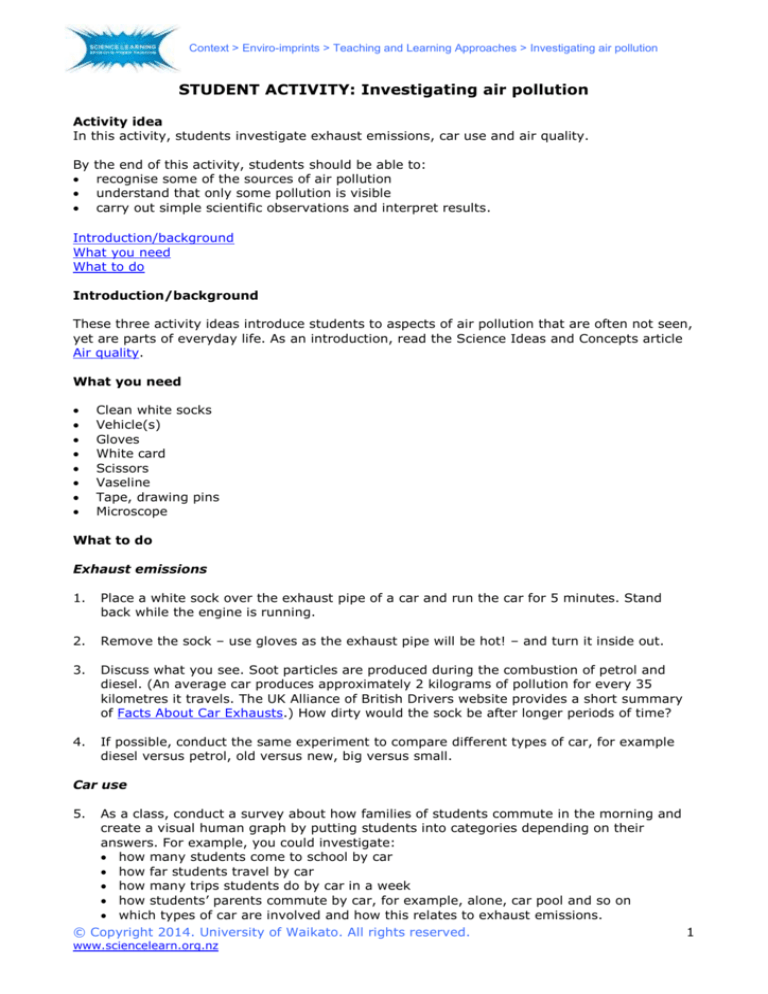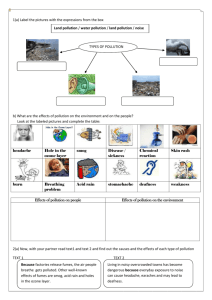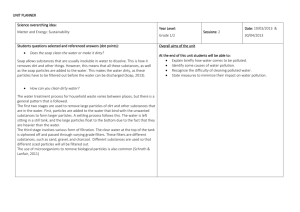
Context > Enviro-imprints > Teaching and Learning Approaches > Investigating air pollution
activities
STUDENT ACTIVITY: Investigating air pollution
Activity idea
In this activity, students investigate exhaust emissions, car use and air quality.
By
the end of this activity, students should be able to:
recognise some of the sources of air pollution
understand that only some pollution is visible
carry out simple scientific observations and interpret results.
Introduction/background
What you need
What to do
Introduction/background
These three activity ideas introduce students to aspects of air pollution that are often not seen,
yet are parts of everyday life. As an introduction, read the Science Ideas and Concepts article
Air quality.
What you need
Clean white socks
Vehicle(s)
Gloves
White card
Scissors
Vaseline
Tape, drawing pins
Microscope
What to do
Exhaust emissions
1.
Place a white sock over the exhaust pipe of a car and run the car for 5 minutes. Stand
back while the engine is running.
2.
Remove the sock – use gloves as the exhaust pipe will be hot! – and turn it inside out.
3.
Discuss what you see. Soot particles are produced during the combustion of petrol and
diesel. (An average car produces approximately 2 kilograms of pollution for every 35
kilometres it travels. The UK Alliance of British Drivers website provides a short summary
of Facts About Car Exhausts.) How dirty would the sock be after longer periods of time?
4.
If possible, conduct the same experiment to compare different types of car, for example
diesel versus petrol, old versus new, big versus small.
Car use
5.
As a class, conduct a survey about how families of students commute in the morning and
create a visual human graph by putting students into categories depending on their
answers. For example, you could investigate:
how many students come to school by car
how far students travel by car
how many trips students do by car in a week
how students’ parents commute by car, for example, alone, car pool and so on
which types of car are involved and how this relates to exhaust emissions.
1
© Copyright 2014. University of Waikato. All rights reserved.
www.sciencelearn.org.nz
Context > Enviro-imprints > Teaching and Learning Approaches > Investigating air pollution
activities
Air quality
6.
Cut out several 50 x 50 mm squares of white card and smear the surface of each lightly
with Vaseline.
7.
Have students fix the squares to as many different areas you can think of, for example, by
the bus stop, inside the classroom, under trees, by a car park, on a post by traffic lights,
on a back door and so on. Leave for 24 hours. (As an alternative, you could use slightly
damp cotton wool to swab different surfaces, such as road signs, leaves on trees, window
panes and so on.)
8.
The squares will now have particles stuck to them. Some will be big enough to see, but
most particles will be too small – try looking at them under a microscope.
Where do you think the particles have come from?
9.
Have students devise a particle pollution indicator, from low pollution to high pollution, for
the cards based on the results you get. It is best to have about five categories.
10. Score each card on how polluted it is and use this data to draw a graph showing the level
of air pollution in the various areas.
11. Discuss the graphs. What areas were least polluted? What areas were most polluted? Are
there any links between the areas that are most polluted?
© Copyright 2014. University of Waikato. All rights reserved.
www.sciencelearn.org.nz
2









